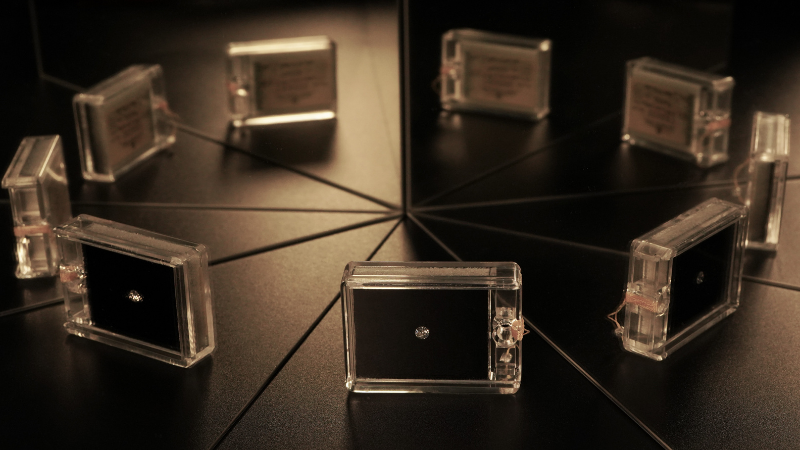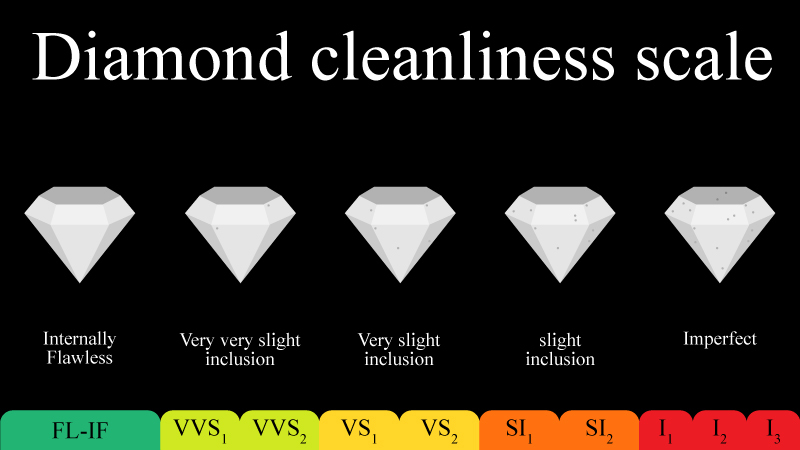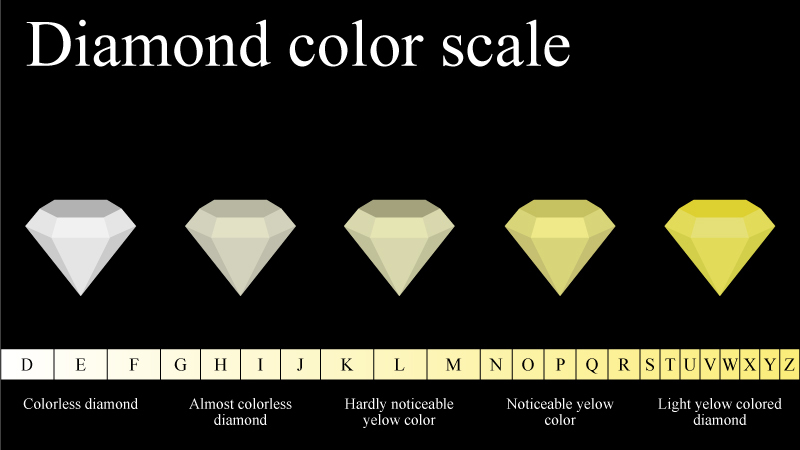Diamonds - how to determine their value and make the right purchase
Time of publication - 2022.02.24
When choosing a diamond that is right for you, a question that probably pops up in your mind is how you can get a better deal? And why are some diamonds are more valuable than others?
When choosing a diamond it is important to keep in mind that they are valued on a number of important criteria. Ability to distinguish it gives you an understanding of factors that influence the price of a diamond and assists you in making the right decision.
Here is everything that you need to know about diamonds, brilliants, and their valuation.
What is the difference between diamond and brilliant diamond?
Diamond - is the largest, most stable, most expensive, and the rarest jewel there is. Diamonds formed billions of years ago in 10-1500 m width craters. Sometimes they also appear to be embedded into cracks within the deeper layers of the Earth’s crust. Diamond is also considered to be the most scratch-resistant jewel.
The name of the element originates from the Greek word “adam” which translates to invincible. Whereas the sparkle of a brilliant is often an analogy to fire in folklore.
So what is the difference between a diamond and a brilliant diamond?
For the processing of the diamond, it is polished until 57 facets. At this stage, diamonds that have no less than 57 facets are considered to be brilliant diamonds.
Diamond is a carbon polymorph class mineral that is completely translucent. That is why due to its facets it creates a maximum, enchanting rainbow-like glow and amazing sparkle. It is believed that the diamond attracts pure energy to its owners, also inspiration, happiness, and wealth.
Diamond valuation
It is obvious that each diamond possesses unique properties. Diamond has specific valuation criteria that are based on
4C classification:
- Cut
- Clarity
- Color
- Carat (weight)
Diamond cuts
Only the most thorough polishing methods help diamonds that acquire maximum and natural light reflection and amazing rainbow-like glow. Expert value diamond cutting quality according to the five criteria:
- Excellent cut. A very shiny brilliant diamond that ideally reflects all of the light sources and is in a perfectly symmetrical shape.
- Very good cut. Very shiny brilliant diamond with a neat symmetry that reflects slightly less light than excellent cut.
- Good cut. Great shine and neat faceting however it reflects less light.
- Fair cut. Cut of medium quality that reflects way less light than the good cut.
- Poor cut. Insufficient shine, unsatisfactory faceting, and glare. Reflects only a tiny amount of light.
Diamond clarity chart
This is the second most important valuation criterion of brilliant diamonds. It is common for the majority of naturally occurring diamonds to be slightly impaired and possess tiny cracks and inclusions that are not visible to the naked eye. In the laboratories, experts conduct clarity evaluation based on specific guidelines:
- I1, I2, I3 visible inclusions. Diamonds have inclusions that can be detected by the naked eye.
- SI1, SI2 slight inclusions. The naked eye very rarely detects these inclusions. They are often detected by the magnifying glass.
- VS1, VS2 very slight inclusions. Defects cannot be detected by the naked eye. Magnifying glass, a microscope that zooms up to 10 times may help to detect these inclusions.
- VVS1, VVS2 extremely tiny amount of inclusions. Very hard to detect even with the most advanced equipment.
- FL, IF Flawless, INnternalyl Flawless. Doesn’t have internal or external inclusions or defects. These brilliant diamonds are of the highest quality and are particularly rare.
Diamond color scale
The third most relevant factor behind the value of a diamond is its color. Diamond industry bases color classification in alphabetical order from D to Z.
Diamonds tend to possess pink, blue, red, yellow, brown, or greenish hues. The rarest, most expensive, and most valuable diamonds are usually colorless and fall into the D part of the scale. Therefore experts classify the color of the diamond from D (colorless brilliant diamonds) to the letter Z (a color that can be detected by the naked eye).
Usually, Z classified color diamonds contain a visible yellowish hue which reduces the value of the diamond. The most common colors of the diamond include Z, P, L, H, and D categories. From this classification order, more sub-categories derive that represent a concrete color of the diamond. These categories are as follows:
- Z-S Light yellow-colored diamonds. These are brilliant diamonds with a visible color that makes them low-value diamonds.
- R-N Very light-yellow colored diamonds. These are the diamonds that possess visible color. These are the brilliant diamonds on the lower end of the value spectrum.
- M-K Barely visible faint-yellow color. These diamonds possess a hue that is barely visible. These are considered good value diamonds.
- J-G Near-colorless. Almost colorless diamonds with a slight hue that is very hard to detect. High-value diamonds.
- F-D colorless. These are colorless diamonds of the D category. Only the most skilled experts can identify such diamonds. They are also remarkably rare, highest value and quality diamonds.
Diamond carat size
Carat is a measurement that helps to determine polished gem and jewlry weight. The General Conference on Weights and Measures in 1907 passed metric carat measurement that equals 200 milligrams (mg) or 0,2 grams (g).
This is the fourth most relevant diamond valuation criterion. The more carats the diamond possess (the heavier, the more expensive and rare it is. That is why a single one-carat diamond is more valuable than a couple of brilliant diamonds combined.
Diamond fluorescence
Fluorescence - is an interesting parameter of the diamond also known as radiance or glow. About 30% of diamonds contain chemical particles that ultraviolet rays turn into different size light waves. That is why natural sunlight or UV rays make the diamond radiate beautiful colors like blue which indicates the element of boron.
Fluorescence doesn’t influence the price of brilliant diamonds that much. However, if you decide to buy J category near-colorless diamonds, with the help of UV lightning it can appear as G colo category diamond. That is why brilliant diamonds that might actually have a yellowish hue can come across as colorless due to UV lightning.
However, if the diamond possesses a good color, in rare cases (approximately 1% best-colored brilliants) fluorescence can cause a loss of visual gloss or significantly dim it. On the other hand, sunlight can effectively take the beauty of your diamond to the next level.
Diamond certificate (brilliant)
Diamond certification and evaluation documents that pertain to it reveal precise parameters of the purchase: color category, clarity, cut that accordingly determines the market price of the unit.
In the world, there are many institutions that certify diamonds. For example, one of the most famous and most recognizable certifiers is American Geoscience Institute (AGI). People value their reputation that stands for impartiality and high quality and precision in setting diamond parameters.
According to the Laws of the Lithuanian Republic retailers can only sell diamonds that are certified by the Lithuanian Assay Office. That is why fundamentally foreign certificates are not valid in Lithuanian. It is important to keep in mind that whenever you decide to sell your diamond, you will have to certify it again in the Lithuanian Assay Office (Lietuvos Prabavimo Rūmai).
Conclusion
Whenever you look for that perfect diamond, pay attention to the valuation criteria. Based on the biggest influence on the price these criteria rank in the following order:
- Cutting;
- Clarity;
- Color;
- Weight (carats);
Shops that offer to buy diamonds usually lay out all of the information concerning the value content of a brilliant diamond.
Looking to buy diamonds for a good price?
These criteria will help you to determine not only the quality but also recognize whenever retail stores offer you reasonable prices.
Florinus diamond assortment provides you with an opportunity to explore the variety of qualities in the market,
What qualities do you value in jewels the most?
Sign up for the Florinus newsletter and be the first to learn about inventory additions, exclusive promotions, special offers and much more!
Subscribe to the newsletter




